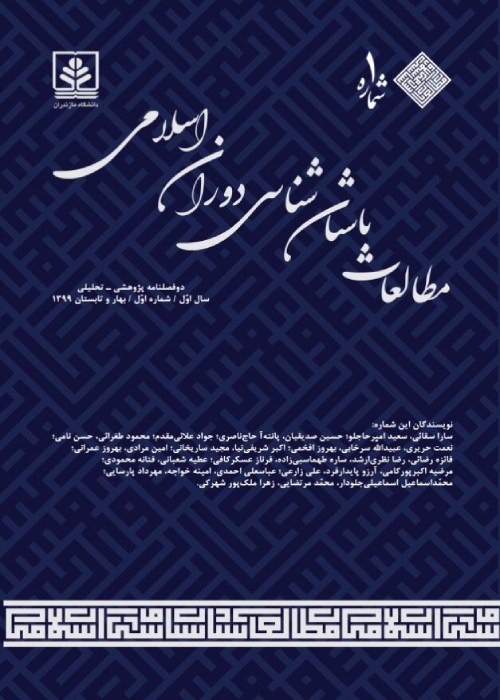Introduction and semiology of the engraved tombstones motifs of the Islamic era in the cemetery of Fash village in Kangavar city
Kangavar city, which is located in the historical context of Kermanshah and due to the existence of Anahita Temple within its territory, has always been studied and recognized by Iranian and foreign archaeologists. While most of the archeological activities carried out in this city have been and currently are centered on Anahita Temple and Godin Tape, the other historical and archeological monuments of this city (especially the Islamic cultural material) are less considered. The purpose of this study is to investigate the tombstones of the Islamic period which are located in Kufi cemetery in Fash village of Kangavar City. In this regard, this article is an attempt to introduce and identify the symbols on the tombstones and the indigenous beliefs about the afterlife. Also, in this article by introducing the repetitious examples, we attempted to prevent them from being forgotten by documenting these motifs.
The cemetery of Fash is located at the Southeastern of Fash village in a mountainous area. This cemetery has a range of tombstones that are dated between the 3th to 6th centuries A.H in general and some of them belong to after this date. These tombstones are classified into two groups of men and women. Tombstones are different in both categories in terms of carvings and decorations. Some tombstones in this cemetery are broken and many of them are buried under a layer of soil. Some scattered tombstones can be seen on the surface of this cemetery that have been removed from their original place. Perhaps the importance of these tombstones can be attributed to the signs and symbols that have been engraved on them.
Most of the engraved signs on tombstones of the Fash cemetery have special meanings. Undoubtedly, the signs were created under the influence of religious and narrative beliefs. Among the various motifs on tombstones, some of them are related to the vocation and somehow represent the occupation of the deceased. Sometimes the use of special concepts of these signs is for the purpose of the convenience of the illiterate members of the society in order to at least recognize the gender of the deceased. In combination, there are 117 tombstones with different motifs in the cemetery which 50 of them have one-sided comb motifs (mark of the deceased male), 34 of them have double-sided combs (mark of the deceased female), 10 altars, 8 Turbans and praying rugs in addition to some motifs such as flowers and etc. can also be seen on tombstones. The motif of čəraq–lalə is engraved in order to illuminate the dark world after the death. The altar’s motif is a religious symbol. The motifs of flowers are meant to fill the empty spaces of the frame at first, but then it turned into a religious feature. The motif of vases on tombstones can represent the job of the deceased which was sewing and also it is considered as symbol of death. The role of the comb is a symbol of the beauty of the deceased; One-sided comb is sign of a male and two-sided comb is sign of a female. The motif of Turban and praying rug is the symbol of asceticism and piety. The motif of a knife and a sword, in addition to the daily use for livelihood, also implies death. The motif of killing a lion with a dagger indicates that the deceased had heroic manners; these motifs are entirely masculine. The motif of the bird is a symbol of freedom and liberation of the soul.
Protecting old cemeteries as cultural and artistic heritage is important. Semilogically, on these tombstones we can witness motifs which represent the popular culture of the people from different eras. The importance of studying tombstones, in addition to the artistic aspects, is in the fact that many of them are being destroyed and eroded. In the Islamic period, the tradition of funerals was held by burying the body in the ground. This method has gradually disappeared and tombstones were decorated with Arabic or Persian script ever since. The master sculptor based on gender (male or female), occupation and lineage (warrior, etc.) has left a good memory for us by engraving on the tombstone and through this phenomenon, we can understand the life and social occasions of this area. By examining the tombstones in the cemetery of Fash village, we can conclude that the culture of the people of this region of Iran has directly influenced the motifs. For example, we can mention motifs such as sword, gun, dagger, etc., which have a special relationship with the moral spirits of these brave people.
- حق عضویت دریافتی صرف حمایت از نشریات عضو و نگهداری، تکمیل و توسعه مگیران میشود.
- پرداخت حق اشتراک و دانلود مقالات اجازه بازنشر آن در سایر رسانههای چاپی و دیجیتال را به کاربر نمیدهد.


